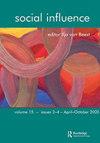思想群体影响:信息意义的中心作用
IF 0.6
3区 心理学
Q3 PSYCHOLOGY, SOCIAL
引用次数: 3
摘要
在阿希的著名分析中,社会影响取决于接受者对问题含义的解释。基于这一观点,我们表明影响是一个两步的过程,在这个过程中,接受者首先根据来源群体的意识形态推断出信息的含义。在第二步中,接受者更同意支持他们自己群体意识形态的信息。支持模型中的因果顺序,当消息意义改变时,接受者的态度会改变,但当消息意义保持不变时,接受者的态度不会改变。本文章由计算机程序翻译,如有差异,请以英文原文为准。
Ideological group influence: central role of message meaning
Abstract Social influence, in Asch’s famous analysis, depends on recipients’ interpretations of what issues mean. Building on this view, we showed that influence is a two-step process in which recipients first infer the meaning of a message based on the ideology of the source group. In the second step, recipients agree more with messages that support their own group ideologies. Supporting the causal sequence in the model, recipients’ attitudes changed when message meaning changed, but not when message meaning was held constant.
求助全文
通过发布文献求助,成功后即可免费获取论文全文。
去求助
来源期刊

Social Influence
PSYCHOLOGY, SOCIAL-
CiteScore
1.50
自引率
0.00%
发文量
4
期刊介绍:
Social Influence is a journal that provides an integrated focus for research into this important, dynamic, and multi-disciplinary field. Topics covered include: conformity, norms, social influence tactics such as norm of reciprocity, authority, scarcity, interpersonal influence, persuasion, power, advertising, mass media effects, political persuasion, propaganda, comparative influence, compliance, minority influence, influence in groups, cultic influence, social movements, social contagions, rumors, resistance to influence, influence across cultures, and the history of influence research.
 求助内容:
求助内容: 应助结果提醒方式:
应助结果提醒方式:


